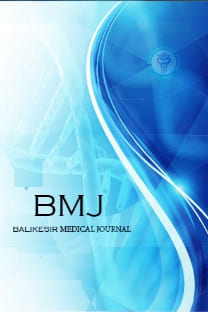Yaşlı hastada miyokart infarktüsünün nadir bir nedeni: Tip 1 Kounis sendromu
81 yaş erkek hastaya,
aile hekimi tarafından, diz ağrısı nedeni ile, nonsteroid antiinflamatuar bir ilaç
olan dikolefanak sodium başlanmış. 100 mg diklofenak sodium intramuskuler
verildikten 30 dakika sonar şiddetli göğüs ağrısı ve jeneralize eritem başlayan
hasta ambulansla acil servise getirildi. Göğüsağrı nedeniyle çekilen EKG’de,
D2, D3 aVF leadlerinde 2-3 mm ST elevasyonu diğer leadlerde resiprokal
değişiklikler saptandı (Figure 1). Acil olarak katater labaratuarına alınan
hastaya yapılan koroner anjiografide koroner arterlerin normal olduğu tespit
edildi (Figure 2,3). Sonrasında Tip 1 Kounis tansı konulup intravenöz
antihistaminik ve 40 mg prednizolon uygulandı. Hasta 2. gün taburcu edildi.
Yaşlı hastalarda da tip 1 Kounis sendromu olabileceğini akılda tutmamız
gerekir.
Anahtar Kelimeler:
Kounis sendromu, Diklofenak
A forgotten cause of myocardial infarction in an octogenarian patient: Type 1 Kounis Syndrome
A non-steroidal antiinflammatory drug, diclofenac sodium, was initiated
to 81 year-old male patient for his knee pain by a general practitioner. After
30 minutes of ingestion of 100 mg diclofenac sodium, severe chest pain and
generalized erythema had started and he was brought to our emergency department
by the ambulance staff. Owing to the chest pain , an ECG was performed and it
revealed 2-3 mm ST segment elevation in DII-DIII and aVF leads and reciprocal
changes in other leads (Figure 1A). Immediately the patient underwent to
catheter laboratory and the coronary angiogram showed normal coronary arteries
without any obstruction (Figure 2,3). Then Kounis Type 1 was diagnosed and
intravenous antihistaminic and 40 mg of prednisolone was administered. The
patient was discharged on the second day. Our case is an example of type 1
Kounis syndrome in an octogenarian patient which we should keep in mind.
Keywords:
Kounis syndrome, diclofenac,
___
- 1- Kounis NG. Kounis syndrome: an update on epidemiology, pathogenesis, diagnosis and therapeutic management. Clin Chem Lab Med. 2016;54(10):1545-59.
- Yayın Aralığı: Yıllık
- Başlangıç: 2017
- Yayıncı: Balıkesir Üniversitesi
Sayıdaki Diğer Makaleler
Femoral Troklear Morfoloji: MRG ile Cinsiyet ve Bilateral Karşılaştırmalı Çalışma
Epidural analjezi ile normal doğum yapanlarda memnuniyet değerlendirmesi
İsa Şükrü ÖZ, Anıl TURHAN ÇAKIR, Burak ÜN, Besim Haluk BACANAKGİL
Yaşlı hastada miyokart infarktüsünün nadir bir nedeni: Tip 1 Kounis sendromu
Tarık YILDIRIM, Seda Elcim YİLDİRİM
Şizofreni ve İntihar; Bir Gözden Geçirme
SUBMÜKÖZ KOLON LİPOMU: BİR OLGU SUNUMU
Serpil PAKSOY, Eren ALTUN, Murat BAŞBUĞ, Nevroz ALIŞ SÖYLEYİCİ
PENİSİN İNCİ PAPÜLLERİ OLGU SUNUMU EŞLİĞİNDE DERMATOPATOLOJİK DEĞERLENDİRİLMESİ
